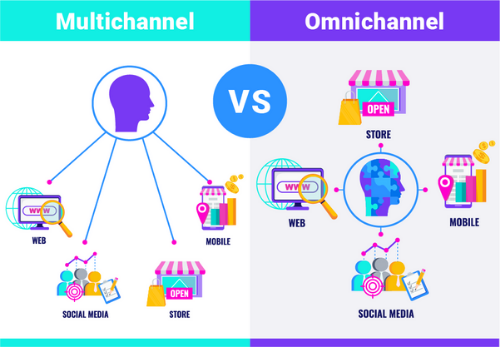Remember in middle school when your geometry teacher said, “a square is a rectangle, but a rectangle isn’t a square?” The same logic applies to multichannel and omnichannel strategy. Omnichannel is multichannel, but multichannel isn’t omnichannel.
Multichannel marketing lacks interconnection between channels for the customer and the company. When channels are used individually, information isn’t recorded and must be re-communicated. The data in a multichannel system is siloed on different platforms. They don’t pass along mission-critical information and could create a bad customer experience (CX).
Multichannel marketing lacks interconnection between channels for the customer and the company. When channels are used individually, information isn’t recorded and must be re-communicated. The data in a multichannel system is siloed on different platforms. They don’t pass along mission-critical information and could create a bad customer experience (CX).
The interconnection of omnichannel marketing allows for the possibility of customer self-service. By connecting business-side customer relationship management platforms with customer-side communication platforms via SaaS and AI, customers can help themselves.
Omnichannel benefits like higher ROI come fast to businesses. With a platform like Marketplace, non-developers can add this value in days. So, how do you create an omnichannel strategy and gain these benefits?
Creating your omnichannel strategy
Creating an omnichannel strategy may sound daunting, but, for some, the process is an exciting challenge. You’ll identify customers’ experience with a journey map. Digital Marketer has a great eight-step guide on how to do this at a high level.
Map out your customers’ experience
Knowing the customers’ experience and teaming up with a company like IntelePeer helps simplify the experience. Specifying when and where customers interact with your business is the first step. Creating a customer journey map that highlights the steps a customer takes and the communications channels they prefer to engage in will help maximize the value of leads moving forward.
You’ll probably want to take journey mapping a step further by identifying each touchpoint with customers. For example, a patient looking for a dentist may look like this:
- Awareness – Hearing about the practice from a friend
- Engagement – Comparing ratings online
- Subscribe – Spending time on the website
- Convert – Scheduling an appointment
- Excite – Receiving an automated text reminder three days before an appointment
- Ascend – Needing to reschedule and doing so easily
- Advocate – Giving a great testimonial via an automated survey
- Promotor – Telling friends and family to go to the practice
While each customer journey map may look different – and more detailed – it should generally follow these steps. The more touchpoints identified, the better your omnichannel strategy will be.
Do you want to learn more about modernizing your contact center and accelerating customer engagement with generative AI and automation? Schedule an AI and automation Customer Interaction Intent Study with IntelePeer now.
Maximizing customer satisfaction
Did you know “Gartner finds that 70% of customers are using self-service channels at some point in their resolution journey” (Gartner)? If you’re not thinking about automating touchpoints, you’re in the minority – and at a disadvantage for providing great service.
With the journey mapping done, start tailoring each touchpoint to customers’ preferences. Sticking to our example, patients receive an appointment reminder three days before a scheduled appointment.
If they indicate that they can’t make it, you can still help them move on in the journey and avoid a no-show appointment. This task doesn’t have to bother a busy administrator, either. Rather, it frees up admin time, allowing them to do more meaningful work. Automation could call the patient to reschedule the appointment.
After that, an automated text could be sent to a second patient who’d like to take the earlier appointment. The second patient could confirm the rescheduling and fill in for the first patient.
Provide preferred touchpoints
In our example, your patient conveniently rescheduled using their phone to text and talk. But what if that wasn’t the case? Maybe customers are workaholics who don’t have time to pick up a mug of coffee, much less their personal cell phone.
If you identify a unique situation like this during journey mapping, make accommodations. Provide customers with a better touchpoint online. Simply add a self-service appointment scheduler or even integrate a chatbot. Website visitors can make an appointment in less than 60 seconds between meetings.
Do you think the same busy customer would take the time to call? Would they have made an appointment? Maybe not. Customizing touchpoints to customer preferences can make businesses more profitable.
Increase profits with omnichannel strategy
As you can imagine, our example provides a great experience. The busy administrator doesn’t have to be bothered. And now, two patients are satisfied instead of one. What’s more, both patients are more than happy due to the fast and flexible self-service. You provided them with an experience that fits their busy lifestyle.
Your customer knowledge and customization results in better cashflow and potentially two promoters. Instead of a no-show, an appointment gets rescheduled. Instead of an empty dentist chair, you get a paying patient.
Your company is more productive and profitable with an omnichannel strategy. Plus, customers are more pleased to do business.
Improve customer experiences across industries
Imagine these solutions across industries. Journey mapping, self-service, and automation can aid in so many ways. A hotel guest may need a copy of the bill. Connected systems could provide this and document the interaction without the support of a live agent. The guest could have the choice to receive their bill via email or SMS – whatever they prefer. And if the guest has a question, they could be connected to a customer service representative who is prompted to speak to the customer about their bill. That’s great CX.
It’s well worth taking the time to map out the customer journey, identify touchpoints, and flag preferences. Building an omnichannel strategy can make doing business with your company better for customers, relieve staff, and increase profitability. Good experiences like our examples are now expected of almost every company and organization. If you aren’t already, it’s time to get strategic and connect platforms for a great omnichannel strategy.

